Seeded Multigrain Sourdough Bread Recipe is a wholesome delight that combines the heartiness of multigrain grains with the tanginess of sourdough. This easy-to-follow recipe results in a fluffy loaf that’s perfect for any occasion, taking just a few hours from start to finish. Enjoy the nourishing flavors of this Seeded Multigrain Sourdough Bread Recipe, and make it a staple in your kitchen!
I fondly remember the weekends spent baking bread with my mom, Julia, as the warm aromas filled our home. Every loaf tells a story, and from those moments, I created this Seeded Multigrain Sourdough Bread Recipe to share with my daughters. It’s perfect alongside a bowl of hearty vegetable soup, reminding us of the beauty in simple, delicious foods. If you’re diving into sourdough baking, you might also wonder—Can you freeze sourdough starter? Here’s what you need to know to keep your starter ready whenever inspiration strikes.
Why you’ll ❤️ Seeded Multigrain Sourdough Bread Recipe
- Flavorful Each bite bursts with a nutty, rich flavor that enhances any meal, making it your go-to bread.
- Texture The perfect crusty exterior and soft, chewy interior provide a delightful contrast that everyone loves.
- Easy to Make With simple steps, even novice bakers can create this delicious bread without stress.
- Versatile Enjoy it as toast, sandwiches, or with soups; this bread adapts to every occasion and palate.
Ingredients for Seeded Multigrain Sourdough Bread
Dough:
- Active sourdough starter
- Warm water
- Bread flour
- Whole wheat flour
- Sea salt
Seeds:
- Sesame seeds
- Pumpkin seeds
- Sunflower seeds
- Chia seeds
- Hemp hearts
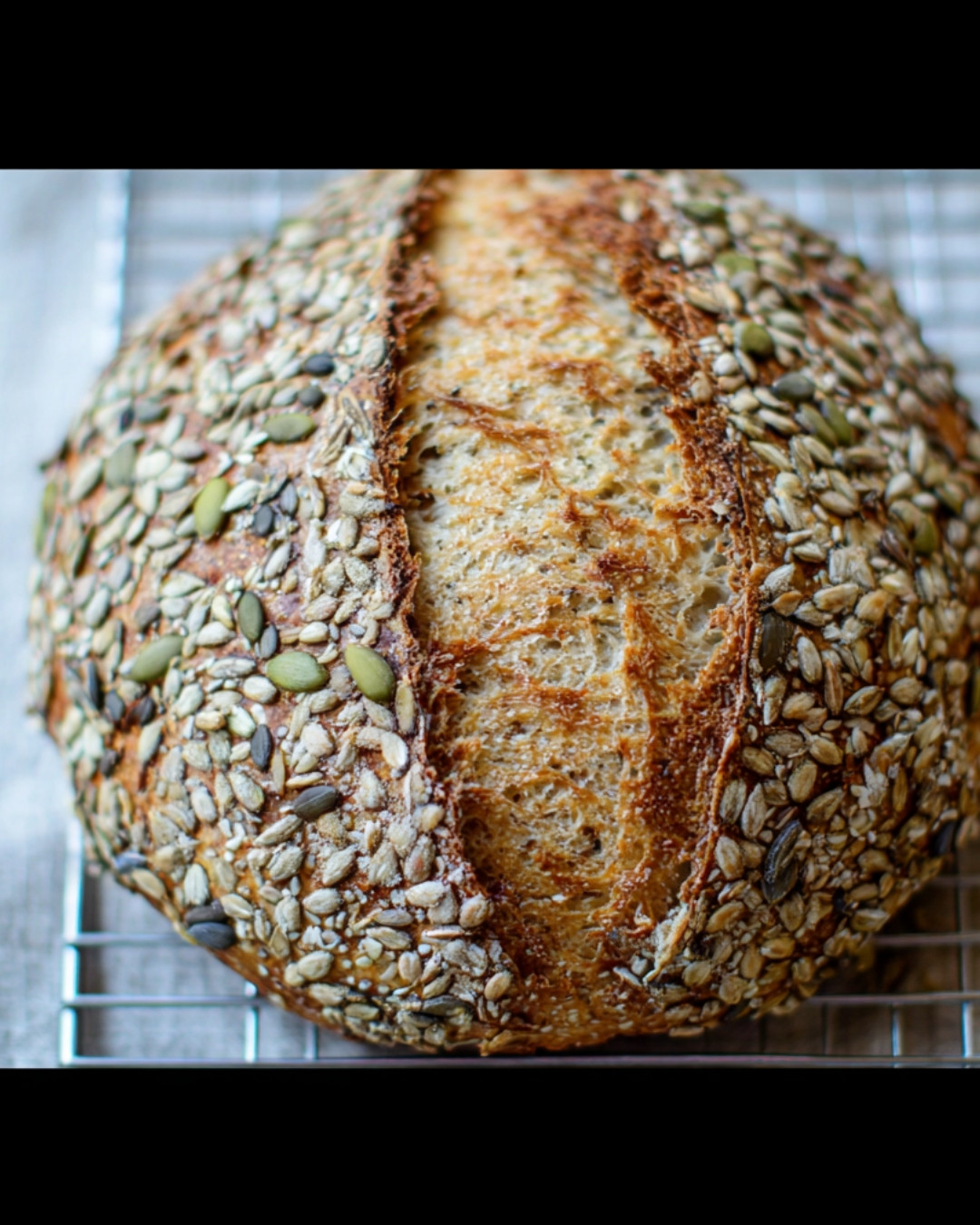
Step-by-Step Cooking Instructions
- Step 1: Prepare the Starter
Begin by mixing your sourdough starter with water and whole wheat flour. This activates the yeast and sets the foundation for your bread. - Step 2: Combine Ingredients
In a large bowl, mix the activated starter with additional water, salt, and all-purpose flour, creating a sticky dough that begins to take shape. - Step 3: Knead the Dough
Transfer your dough to a floured surface and knead it for about 10 minutes. This builds gluten, giving your bread its chewy texture. - Step 4: First Rise
Place your kneaded dough in a lightly oiled bowl and cover it with a damp cloth. Allow it to rise until it doubles in size, which may take 4 to 12 hours depending on temperature. - Step 5: Shape the Loaf
Once risen, gently punch down the dough and shape it into a round or oblong loaf. Be careful not to deflate it completely; you want to preserve some of the air bubbles. - Step 6: Second Rise
Place the shaped loaf into a proofing basket or bowl lined with a floured cloth. Cover and let it rise for another 2 to 4 hours until puffy. - Step 7: Preheat the Oven
Preheat your oven to 450°F (232°C) while the loaf is undergoing its second rise. A hot oven is essential for achieving a good crust. - Step 8: Score the Loaf
Just before baking, carefully score the top of your loaf with a sharp knife or razor. This allows steam to escape and helps control the Bread’s expansion. - Step 9: Bake
Place your loaf in the preheated oven and bake for 30 to 40 minutes, or until the crust is golden brown and the loaf sounds hollow when tapped. - Step 10: Cool Before Slicing
Once baked, transfer your bread to a wire rack and let it cool completely before slicing. This step helps set the texture and flavor.
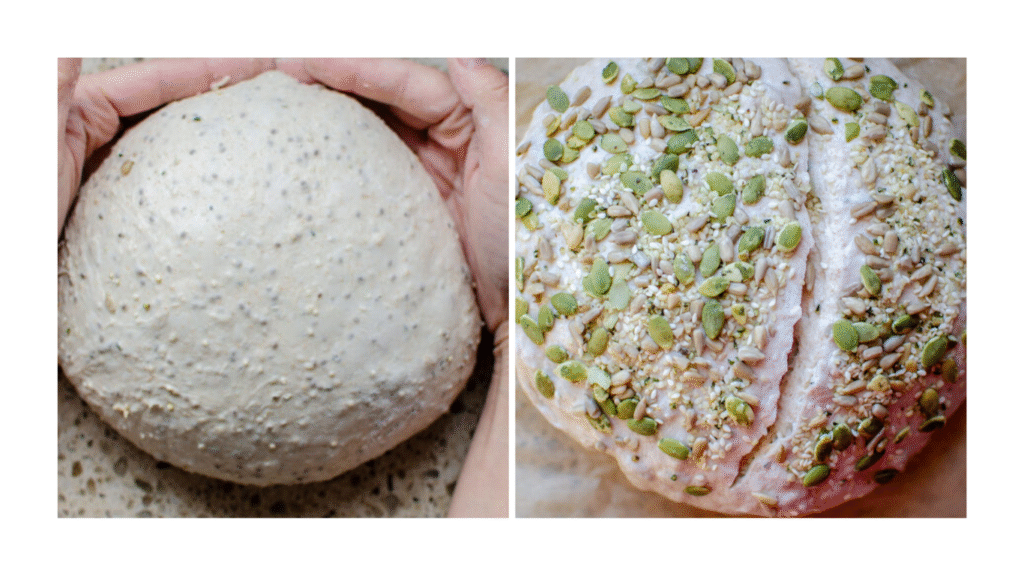
Notes
- Tip 1: Hydration Matters
The dough should be sticky but manageable. Adjust the water or flour if necessary to achieve a pleasing consistency. - Tip 2: Use Fresh Ingredients
For the best flavor, ensure your sourdough starter is active and bubbly. Fresh flour will also enhance the aroma and taste. - Tip 3: Don’t Rush the Rise
Patience is key in sourdough baking. Allowing the dough ample time to rise can significantly improve the final product. - Tip 4: Experiment with Seeds
Add your favorite seeds like sunflower, flax, or sesame to the dough for added flavor and texture. - Tip 5: Store Properly
Once cool, store your bread in a paper bag at room temperature or freeze it for longer freshness.
Seeded Multigrain Sourdough Bread Benefits
Seeded multigrain sourdough bread is a great source of healthy fats and fiber, which can support digestion and help balance blood sugar levels. Thanks to the fermentation process, it’s also easier to digest and packed with more available nutrients. So, is it a healthy choice? Absolutely—especially compared to regular bread. The addition of seeds and whole grains gives it even more nutritional value. Like with everything, moderation matters. In our home, we love enjoying homemade, long-fermented sourdough as a wholesome source of carbs. If you’re looking for a flavorful twist, try this Jalapeño Cheddar Sourdough—a spicy, cheesy favorite!
Seeded Multigrain Sourdough Bread Recipe – A Closer Look
The beauty of the Seeded Multigrain Sourdough Bread lies not just in its crusty exterior, but also in the delightful medley of seeds and grains infused within. Each slice is a celebration of taste and texture, from the nutty crunch of sunflower seeds to the subtle earthiness of flax. The fermentation process enhances the flavors while also promoting a lovely, airy crumb that contrasts beautifully with the hearty seeds. This isn’t just bread; it’s a testament to tradition and craftsmanship, embodying the love and care that goes into sourdough baking.
Bringing It to Your Kitchen
Imagine slicing into a warm loaf of Seeded Multigrain Sourdough Bread fresh from the oven, the aromatic steam wafting through your kitchen. This bread is perfect for family gatherings, where everyone can enjoy a slice topped with creamy butter or transformed into sandwiches full of flavor. Serve it at brunch with a fresh salad or as a comforting dinner side with soup. It’s a versatile companion that brings people together, sparking conversations and shared experiences around the table.
Common Mistakes to Avoid
When attempting to bake your Seeded Multigrain Sourdough Bread, a few pitfalls can easily arise. One common mistake is not allowing the dough to rise long enough; under-proofed dough can result in a dense loaf. Additionally, be cautious with your oven’s temperature; an overly hot oven can burn the crust while leaving the inside doughy. Lastly, always remember to handle the dough gently during shaping and scoring to preserve the air pockets within—this will ensure you’re rewarded with a light and airy texture.
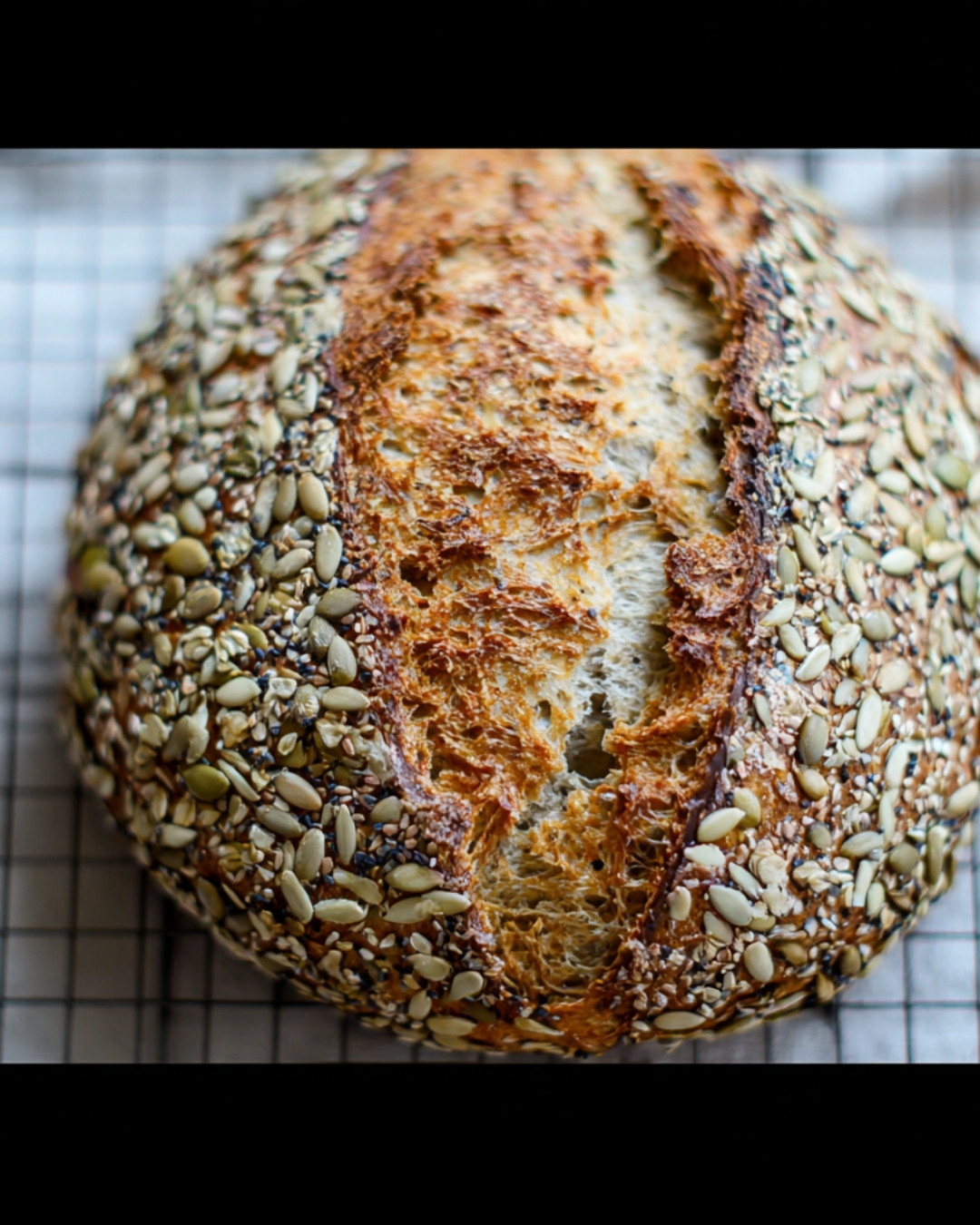
Cook Techniques
Preparing Your Dough
Stretch and Fold
Proofing
Baking
Serving and Presentation Ideas
Classic Breadboard Display
Jam and Cheese Pairing
Sandwich Delight
Conclusion
For more delicious recipes and cooking inspiration, follow me on Facebook and Pinterest!
People Also Ask :
Is multigrain sourdough bread healthy?
Yes, multigrain sourdough bread is healthy due to its combination of whole grains, which provide fiber, vitamins, and minerals. Its fermentation process can also enhance gut health.
Can you make multigrain sourdough?
Absolutely! You can create multigrain sourdough by incorporating various whole grains like oats, seeds, and bran into your dough for added flavor and nutrition.
What is the healthiest type of sourdough bread?
The healthiest sourdough bread tends to be whole grain sourdough, as it retains more nutrients and fiber compared to white sourdough varieties.
Does whole grain sourdough exist?
Yes, whole grain sourdough does exist and is made using whole grain flours. It’s a nutritious option packed with fiber and has a rich flavor profile.
What makes sourdough bread different from regular bread?
Sourdough bread uses a natural starter for fermentation, which creates a distinct tangy flavor and improves digestibility compared to regular bread that uses commercial yeast.
Seeded Multigrain Sourdough Bread Recipe
Discover the ultimate Seeded Multigrain Sourdough Bread Recipe that’s perfect for any baking enthusiast. Packed with a hearty mix of grains and seeds, this Easy Multigrain Sourdough Recipe will surely become a family favorite. Ideal for those who adore Multigrain Sourdough Bread with its rich texture and delicious flavor. Ready to elevate your homemade bread game? Click to dive into this delightful recipe and enjoy the wholesome goodness in every slice!
- Prep Time: 2 hours 45 minutes
- Cook Time: 40 minutes
- Total Time: 3 hours 25 minutes
- Yield: 1 loaf 1x
- Category: Sourdough
- Method: Baking
- Cuisine: American
Ingredients
- 1½ cups warm water (350 g)
- 3 cups bread flour (400 g)
- ½ cup + 1 tsp whole wheat flour (100 g)
- 2 tsp salt (10 g)
- ⅓ cup + 1 tbsp active sourdough starter (100 g)
- ¼ cup sunflower seeds
- ¼ cup pumpkin seeds
- 1 tbsp sesame seeds
- 1 tbsp hemp hearts
Instructions
Step 1: Prepare the Starter
Begin by mixing your sourdough starter with water and whole wheat flour. This activates the yeast and sets the foundation for your bread.
Step 2: Combine Ingredients
In a large bowl, mix the activated starter with additional water, salt, and all-purpose flour, creating a sticky dough that begins to take shape.
Step 3: Knead the Dough
Transfer your dough to a floured surface and knead it for about 10 minutes. This builds gluten, giving your bread its chewy texture.
Step 4: First Rise
Place your kneaded dough in a lightly oiled bowl and cover it with a damp cloth. Allow it to rise until it doubles in size, which may take 4 to 12 hours depending on temperature.
Step 5: Shape the Loaf
Once risen, gently punch down the dough and shape it into a round or oblong loaf. Be careful not to deflate it completely; you want to preserve some of the air bubbles.
Step 6: Second Rise
Place the shaped loaf into a proofing basket or bowl lined with a floured cloth. Cover and let it rise for another 2 to 4 hours until puffy.
Step 7: Preheat the Oven
Preheat your oven to 450°F (232°C) while the loaf is undergoing its second rise. A hot oven is essential for achieving a good crust.
Step 8: Score the Loaf
Just before baking, carefully score the top of your loaf with a sharp knife or razor. This allows steam to escape and helps control the Bread’s expansion.
Step 9: Bake
Place your loaf in the preheated oven and bake for 30 to 40 minutes, or until the crust is golden brown and the loaf sounds hollow when tapped.
Step 10: Cool Before Slicing
Once baked, transfer your bread to a wire rack and let it cool completely before slicing. This step helps set the texture and flavor.
Notes
Tip 1: Hydration Matters
- The dough should be sticky but manageable. Adjust the water or flour if necessary to achieve a pleasing consistency.
Tip 2: Use Fresh Ingredients
- For the best flavor, ensure your sourdough starter is active and bubbly. Fresh flour will also enhance the aroma and taste.
Tip 3: Don’t Rush the Rise
- Patience is key in sourdough baking. Allowing the dough ample time to rise can significantly improve the final product.
Tip 4: Experiment with Seeds
- Add your favorite seeds like sunflower, flax, or sesame to the dough for added flavor and texture.
Tip 5: Store Properly
- Once cool, store your bread in a paper bag at room temperature or freeze it for longer freshness.
Nutrition
- Calories: 2190.6 kcal
- Sugar: 2.8 g
- Sodium: 2.8 g
- Fat: 45.1 g
- Saturated Fat: 5.3 g
- Trans Fat: 0.01g
- Carbohydrates: 372g
- Fiber: 27.4g
- Protein: 80g

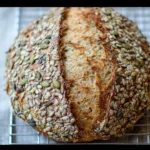






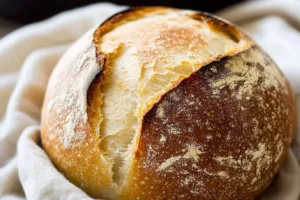

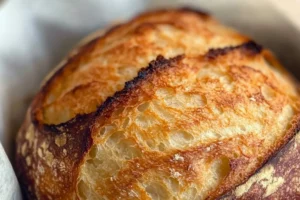
1 thought on “Seeded Multigrain Sourdough Bread Recipe”